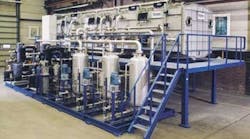In addition, the filters can wash in either co-current or countercurrent mode, and can incorporate compression and/or thermal drying features, to recover drier solids. In some chemical processing applications, the filters are replacing such traditional separation equipment as centrifuges, Nutsche and pressure filters.
HVBFs can be operated in one of three modes, depending on the degree of vacuum required:
Fume-tight operation
Figure 1. Fume-tight Operation for Pharmaceuticals
The HVBF shown here operates in fume-tight mode. Hot air is drawn through the filter cake to dry it. This installation produces a citrus peel extract that has pharmaceutical applications. Since high levels of cleanliness are required, air is used in a closed-loop recirculation system.
Figure 2. Overpressure Prevents Contamination
The HVBF shown here is operating in fume-tight mode with overpressure. The unit produces an artificial sweetener, so strict standards of cleanliness are required. The overpressure ensures that product is not contaminated by outside sources.
Figure 3. Underpressure Protects Workers and Equipment
Designed to operate in corrosive environments, this HVBF is used in fume-tight mode with underpressure. Note the inlet air filter on unit's roof. The filter also features polycarbonate or polymethyl methacrylate openings that serve as windows and access points for inspection and maintenance.
The fume-tight operating mode allows only a very small amount of in- or out-leakage at the housing seals, because the differential pressure across the housing is so small. It is still necessary, however, to draw air into the enclosure, since air is drawn through the filter cake by the vacuum source. This air can either be recycled via the vacuum pump discharge or drawn into the housing via a filter element, or both approaches can be combined.
For filters operating with slight overpressure in sanitary or pharmaceutical processes, any air coming into the housing from a source other than the vacuum pump loop is clean air that enters via a supply duct.
Clean scene
Since the fume-tight filter mode works with an air atmosphere, doors or entry points can be built into the housing to allow for easy access.
Standing up to corrosion
As with all enclosed filters, those components that require the most maintenance, including filter drives, bearings, valves and actuators, should be placed outside the filter housing. Not only does this placement eliminate potential corrosion, but it minimizes the need for operators to access the inside of the housing.
Gas-tight operation
All seals on the filter, windows, shafts and other components are designed to withhold the internal pressure -- still close to atmospheric -- inside the housing. A small amount of inert gas exits the filter with the cake, but a pressure-control device ensures that the correct level of makeup gas is introduced into the housing to compensate.
More than one recirculation loop may be used for thermal drying, or in cases in which the process requires a different solvent for cake washing and the two solvents need to be separated. In the latter case, each loop would have its own vacuum source.
Gas-tight filters are available with the same design options as the fume-tight machines for ultrapure applications and corrosion resistance.
Ultrapure gas-tight operation
Figure 4. Built-in Cleanroom
This modular system features a housing that functions as its own cleanroom, enclosing its own controlled inert atmosphere. Whenever the filter is opened up, the unit starts up again with an automated validation procedure to bring the filter's internal volume back to cleanroom specs.
The HVBF offers another advantage for ultrapure processing: its filter cloth is continuously cleaned once the cake has discharged, eliminating carryover of product from batch to batch. The filter can be run in batch or semi-continuous mode to ensure batch identity, and to facilitate automation of cleaning cycles and other process steps. In addition, cloth wash liquid can be recycled back onto the filter or returned with the fed slurry, making it possible to recover virtually all of the solids. In solvent operations, the cloth wash liquid is typically the solvent being processed, so there is no risk of product contamination.
When gas-tight horizontal belt units are installed in the pharmaceutical industry on final products, a full validation protocol for the equipment is required.
HVBFs Run Rings Around Centrifuges
Ease of cleaning is critical
As with all sanitary equipment, the primary concern in building a belt filter is ease of cleaning. Designs must address the most obvious areas such as polished surfaces, and rounded corners, and must eliminate all dead spots. Angled nozzles and window openings, filter trays and filter housings must all be made to be self-draining.
When it is time to clean the filter, the cloth wash system can be combined with the slurry feed system and the cake wash boxes for filter tray and filter cloth cleaning. If a 360 nozzle CIP system also is added, cleaning can be extremely thorough and achieved in a relatively short time.
Pressure-tight operation
Still, the HVBF separation process only uses the equivalent of vacuum (maximum 1 atmosphere) as the differential pressure across the filter. The filter's operating principle is identical to that of a conventional atmospheric filter, except that it takes place at an elevated pressure.
To date, filters have been built and installed with design pressures for the housing up to 225 psig and temperatures to 250°C (482°F).
Pressure filters also can be operated with air or nitrogen atmospheres, and aqueous or non-aqueous processes can be handled as well. As with the gas-tight design, the pressure-tight filter can be built to sanitary conditions for final product pharmaceuticals.
From supersize to modular
On the other extreme, the HVBF filter lends itself to compact modular designs and packaging, especially since gas-tight and pressure-tight systems are installed as closed loops. Filtrate receivers, pumps and vacuum pumps can be packaged on one skid, combined with the filter and support structures and access platforms.
Brian Mawson is the vice president of Pannevis Inc., the U.S. subsidiary of Royal Pannevis of the Netherlands.
